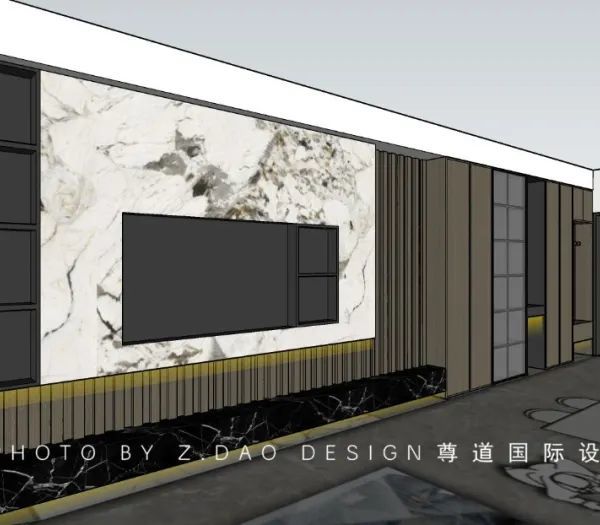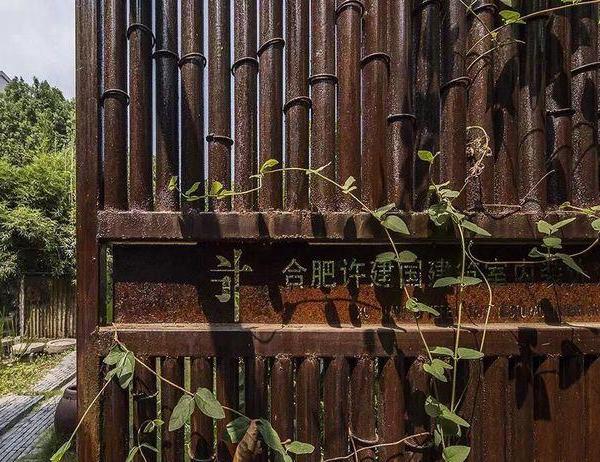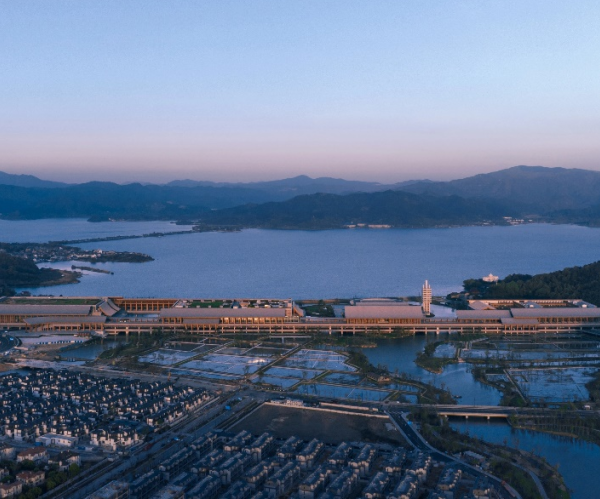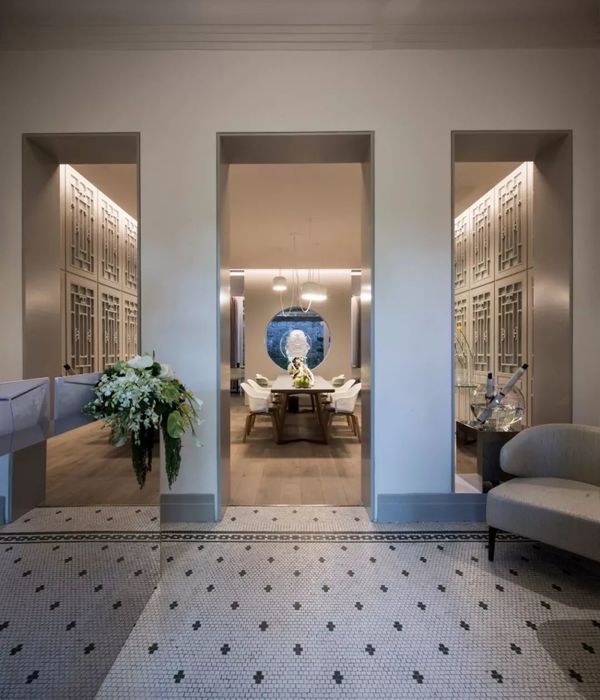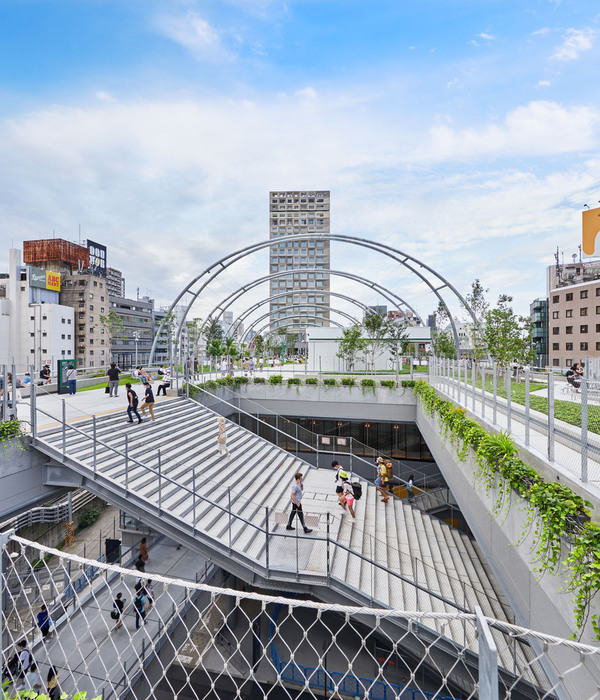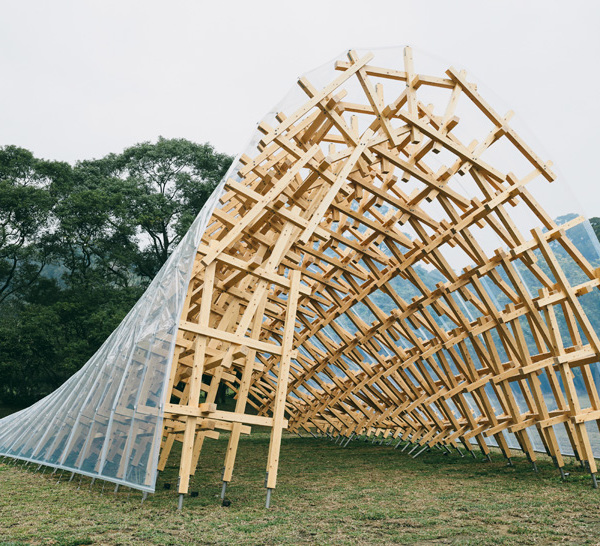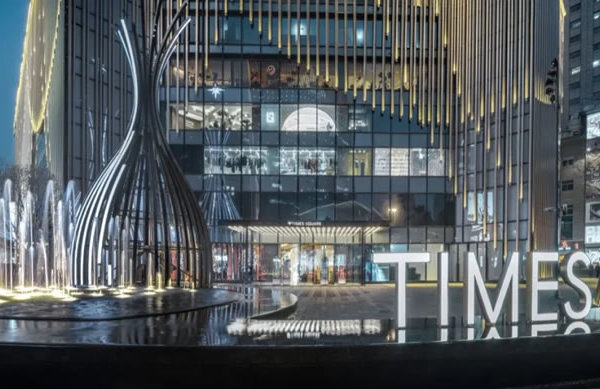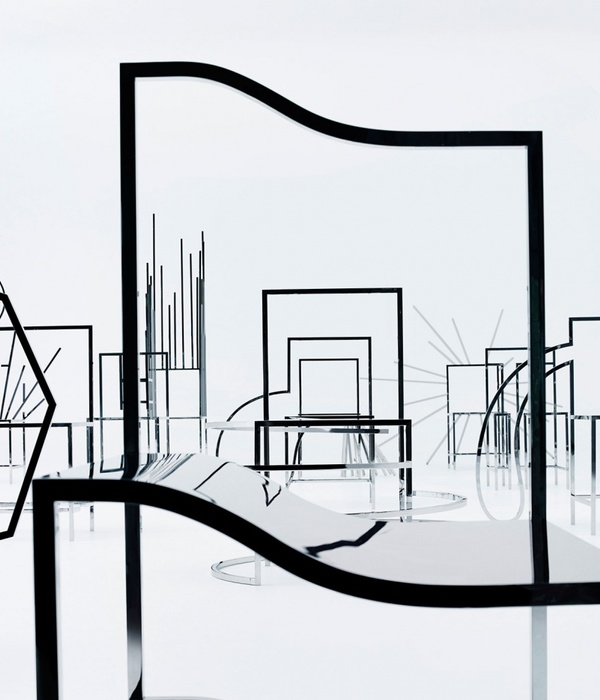甘坑客家小镇南门周边交通及慢行系统改造工程
四十年沧海桑田与岁月变迁,使得深圳这座年轻的城市脉搏加速跳动,容貌愈发崭新,有关过去的记忆,更像是粒粒细沙被洗去一切浮絮愈显熠熠发光。古城之于深圳,见证着这座新城市发展的起点,代表了一群人的生活方式。古城街区的更新如何依托资源禀赋、留下城市文脉并重新得到人们的关注,成为我们应该重点探索和关注的问题。
SUTPC : Forty years have gone by, and the changes have made Shenzhen, a young city, pulse faster and look brand-new. The traces of past memory and time are more like fine sand washed away all floating floc shining more and more. The ancient city in Shenzhen is the starting point of the development of this new city, representing the lifestyle of a regional ethnic group. How to rely on the resource endowment, preserve the urban context and carry forward the local history and culture in the renewal of the ancient city has become an issue that we should focus on and pay attention to.
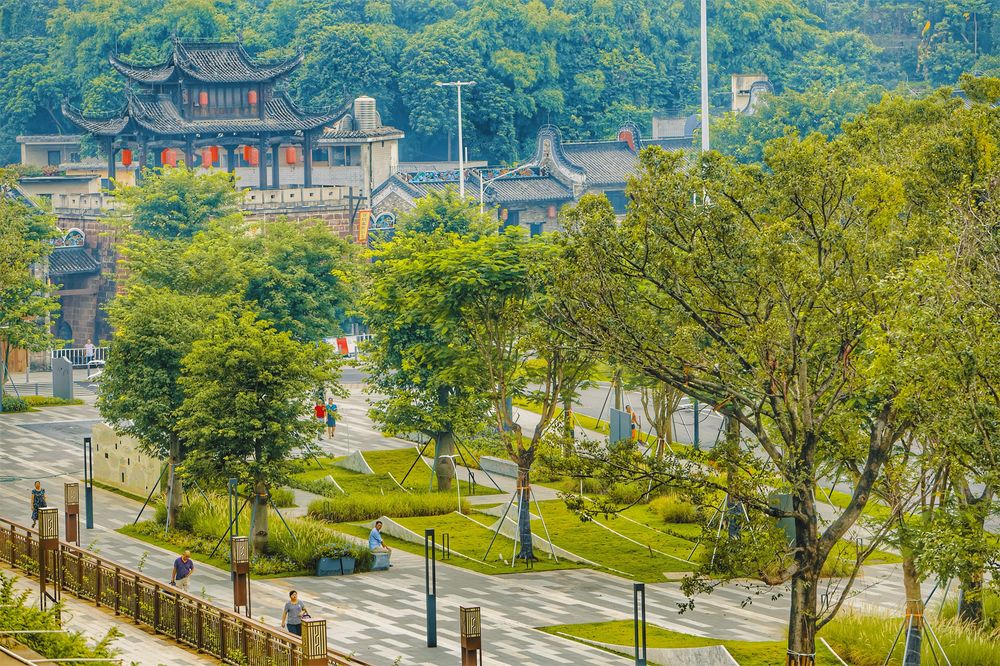
深圳龙岗甘坑村,是一个有着悠久历史的客家围村,起源于明清时期的(甘坑老围),与观澜版画村、鹤湖新居、麻磡村、大万世居等一同被誉为深圳十大客家古村落之一。世代迁徙,甘坑客家形成了“凉帽”“排屋”“清明果茶”等独特文化,其与传统客家有所合又有所不同。小镇具有独特的空间格局、别致的客家建筑及遗存的文化资源,以其高品质的文化遗产吸引大量游客前往观摩。
In Longgang, Shenzhen, Gankeng Village (Gankeng Laowei), originated in the Ming and Qing Dynasties, is a Hakka village with a long history. It is honored as one of the top ten Hakka ancient villages in Shenzhen together with Mission Hills Printmaking Village, Hehu Xinju, Ma Hom Village and Dawanshiju.With generations of migration, Gankeng Hakka has formed “cool hat”, “row house”, “Qingming fruit tea” and other unique culture, which is similar to the traditional Hakka but different. With its unique spatial pattern, unique Hakka architecture and cultural resources, the town attracts a large number of tourists with its high-quality cultural heritage.
多元文化 Multi-culture
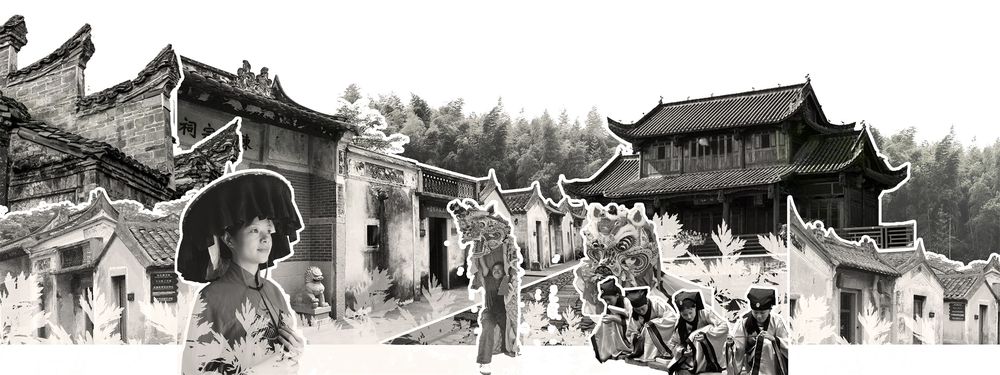
甘李路作为进入甘坑客家小镇南门的城市主街道,在轨道十号线开通后,承担了 60% 公共出行的人流量。通过的需求、杂乱的界面与文化割裂感使场所矛盾重重。团队觉得充满故事的街道才是甘李路魅力所在,其线性的布局更像是一束游走于历史与未来的光,穿过细缝发生衍射,将小镇生活的烟火气、游人的欢声笑语固定在街巷里。深城交与华侨城集团携手为甘李路提供提升方案,旨在对传统的街道空间的营造进行创新探索,用文化激活街道,使之成为人民的街道、活力的街道,成为城市历史感知、在地的生活展示与文化传承的重要的空间载体。
Ganli Road, as the city’s main access to the south gate of Gankeng Hakka town, bears 60% of the public travel flow after the opening of track Line 10. The need to pass through, the disjointed interface and the sense of cultural fragmentation make the place contradictory. Its linear streets are like a dazzling beam of light, diffracting through the cracks, fixing the fireworks and laughter of the town life and visitors in the streets. Shenzhen urban transport planning center CO.,LTD. together with OCT Cultural Property Investment Co.,Ltd was appointed to provide the improvement plan for Ganli Road, aiming to make it a people’s street, a living street, and innovate the construction mode of street space and make the street become an important spatial carrier of the city’s history and culture.
▼场地改造前 The site
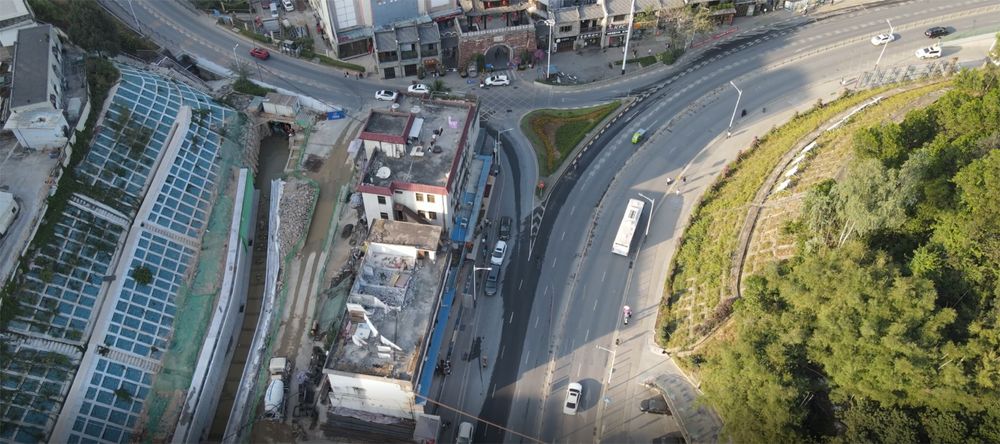
叙事的品质慢行“故事线”|Narrative“story line”泉源甘甜,是为甘坑。碧波荡漾,青山环绕。甘坑的生态资源引得数千只白鹭在此处驻足,展开双翼翩翩起舞;或而成群结伴,涉水而来。故事以白鹭归来为线索,从千年前南迁的客家人,到 360 年前于甘坑开基立村,鹭鸟伴着一代代甘坑人繁衍生息,耕读传家,文脉永续,绵延不绝。
我们以“白鹭“为表达符号,以历史脉络为线索,将客家文化符号嵌刻其中,以图像元素糅合小镇文化,展开自然生态、农耕文化、客家历史于一体的弘扬中国传统文化的旅程,营造“白鹭随风起,满目水与月”的唯美意境,串联引导游人入境的故事线。
The ecological resources of Gankeng attract thousands of egrets, which is the second-class national protected animals, to stop here and spread their wings and dance, or wading in groups. The story takes the return of egrets as a clue, from the Hakka people who moved southward one thousand years ago, egrets have companyed with generations of Gankeng people to reproduce and live, farming family. We take “egret” as the symbol and history as the clue, with the hakka culture symbols engraved among them, and image elements of small town culture mixed with them.
We‘ll go on a journey carrying forward Chinese traditional culture with natural ecology, farming culture and hakka history, to create “egret in the wind, with water and moon” aesthetic artistic conception, in series to guide visitors entry story line.门广场鸟瞰 Aerial view of Nanmen Square
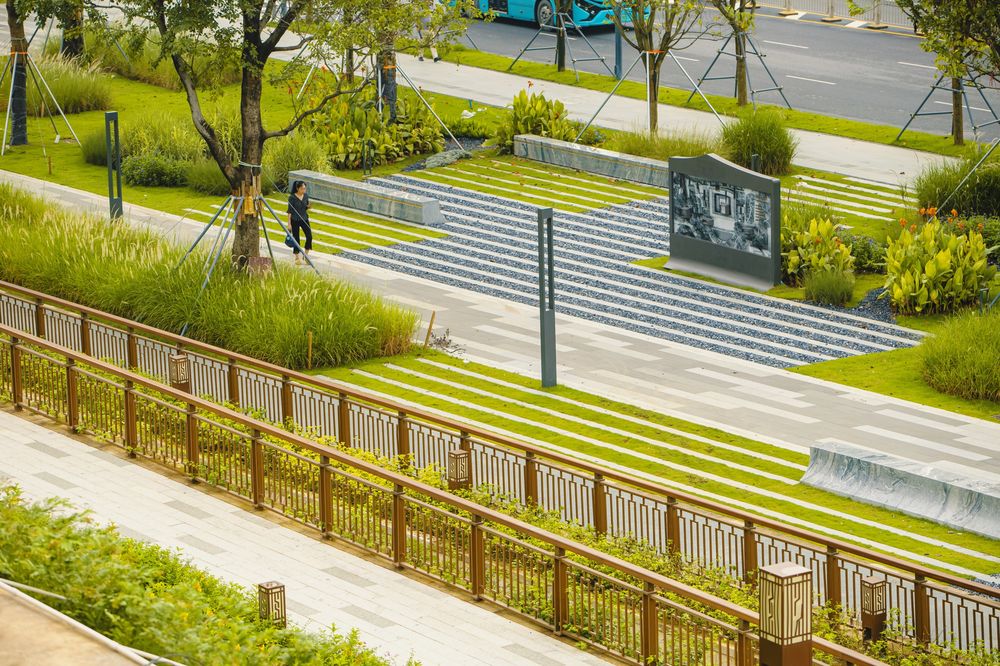
引境入画的街道广场空间|Street square space
以广场南城门为界,内巷曲折深巷,青砖黛瓦,走进其中,如同踏入了一幅淡彩的水墨画中;外街空间丰富,现代简洁,其浓厚的文化氛围激发人们一探究竟,城内外以一个故事表达了两种情境,神合而形异。南门广场作为进入小镇的集散入口,其对原有的街巷空间进行复刻并解构,形成一处现代的文化互动空间;同时与古镇大门时空碰撞,与墙后的沉浸式古城形成对比。
小镇南门内外 Inside and outside the south gate of the town
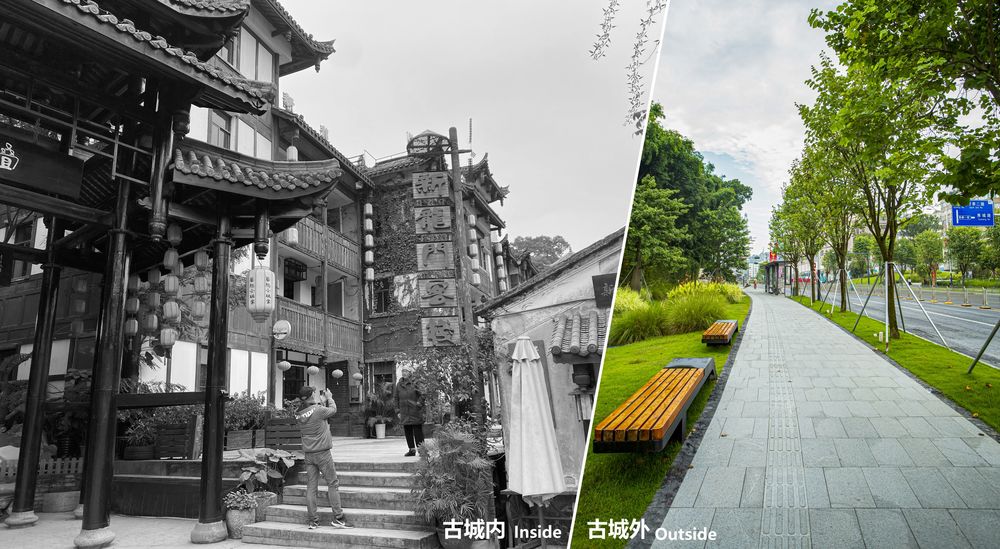
道路东侧快行线 & 雨水花园 Express lane on the east side of the road & rain garden
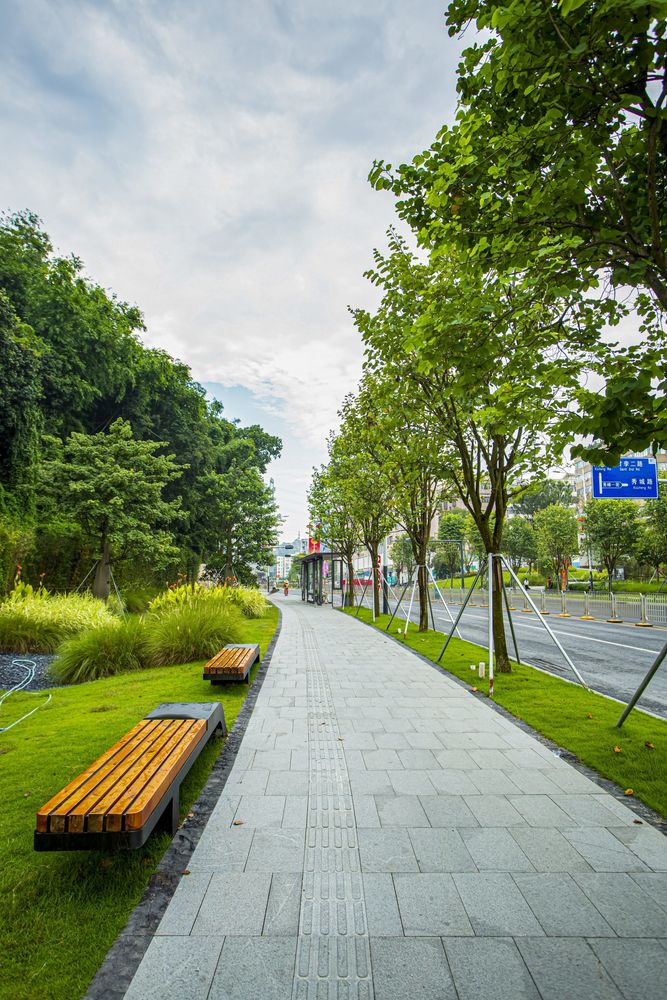

客家建筑屋面的元素给予空间充分的想象力,奔跑的孩童,如飞驰穿梭在层峦叠级的屋顶,一声呼哨,唤回一群归巢的白鹭。屋脊、檐角、青砖、瓦片,通过重构,融入到艺术地形、广场坐凳设计中,点滴细节皆是客家文化的缩影。
The elements of the roof of Hakka buildings give the space full imagination. Children running in the square are like speeding through the cascading roofs. With a whistle, they call back a group of egrets returning to their nests. Roof ridge, eaves corner, blue brick, tile, through reconstruction into the artistic terrain and square seating design, every little detail is the epitome of Hakka culture.
▼艺术地形提取屋脊元素 Artistic terrain extracts roof elements
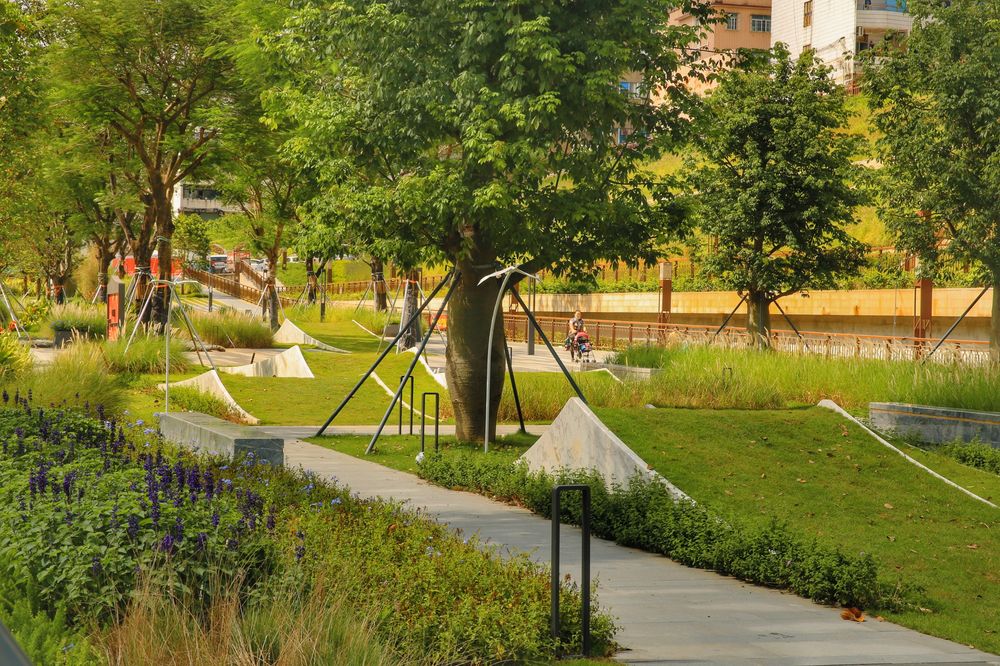
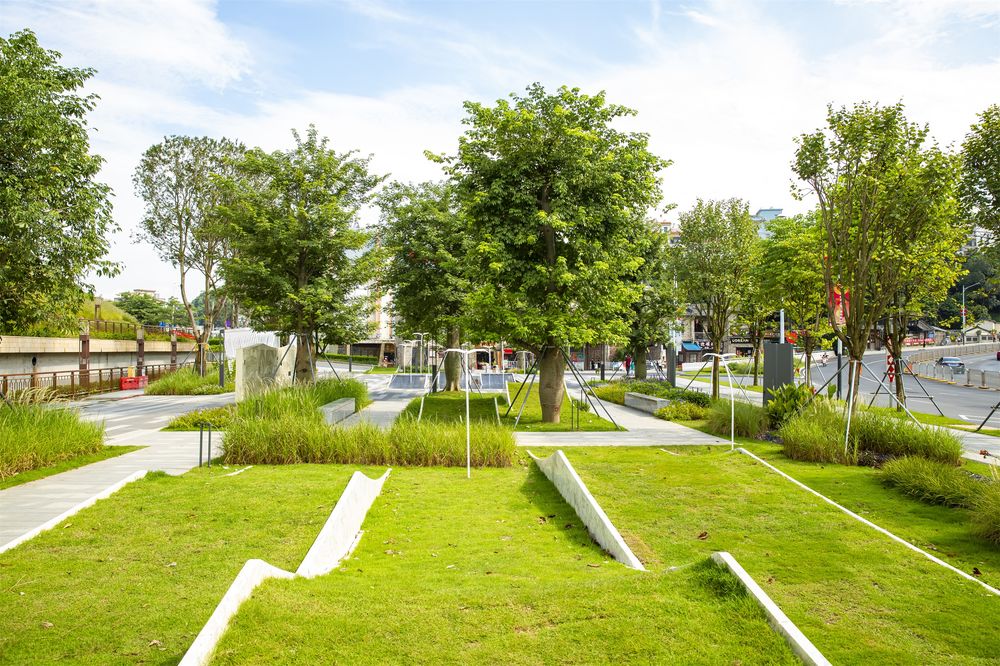
▼艺术地形夜景展示 Artistic terrain night view display
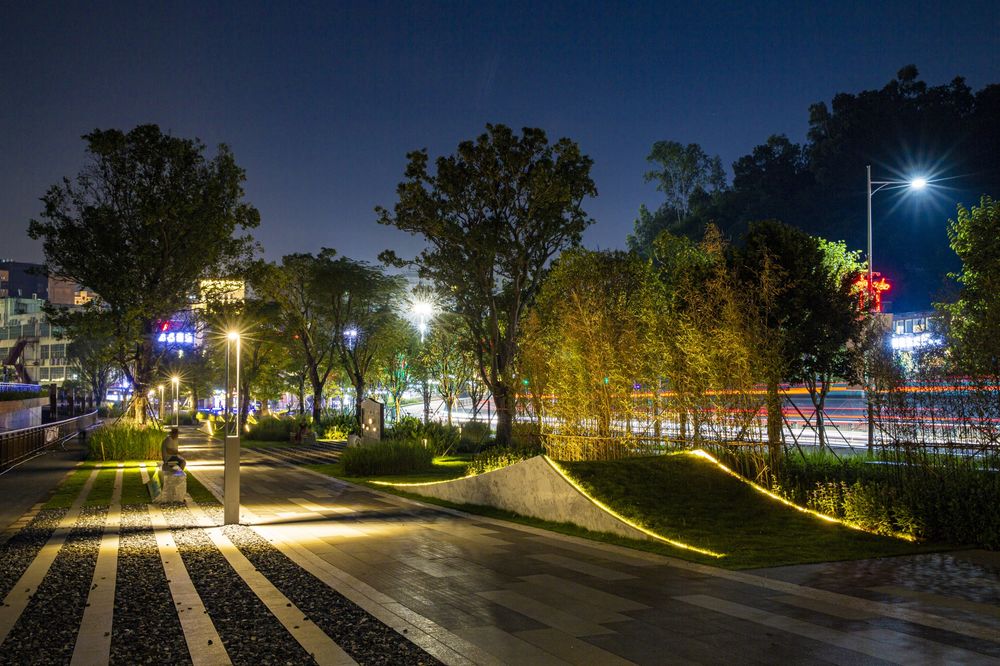
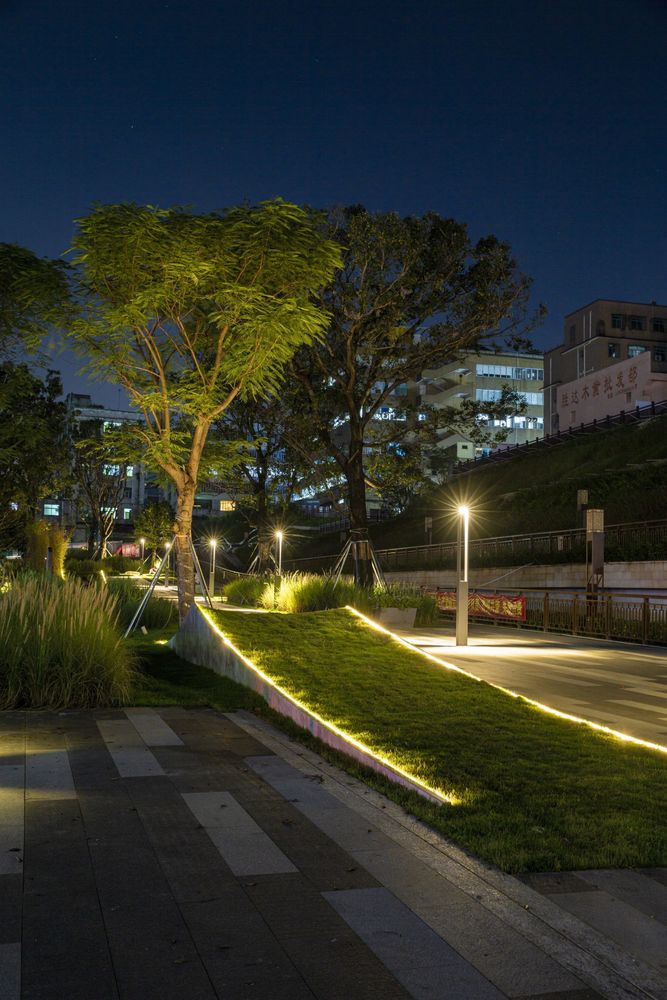
水景、古树、广场即承担了集散的功能,又是凝聚活力的核心场所。艺术地形水景如静景,似女子坐卧窗台,雨打屋檐;中心喷泉水景如动景,似人们偶谈,惊起白鹭。
The water feature is the core element of the plaza. Art waterscape is a static scene, like a woman sitting on the windowsill watching rain hit eaves; The central fountain water feature is a moving scene, seems like people talking and startling the egret.
▼“白鹭”涉水 Egrets standing in the water
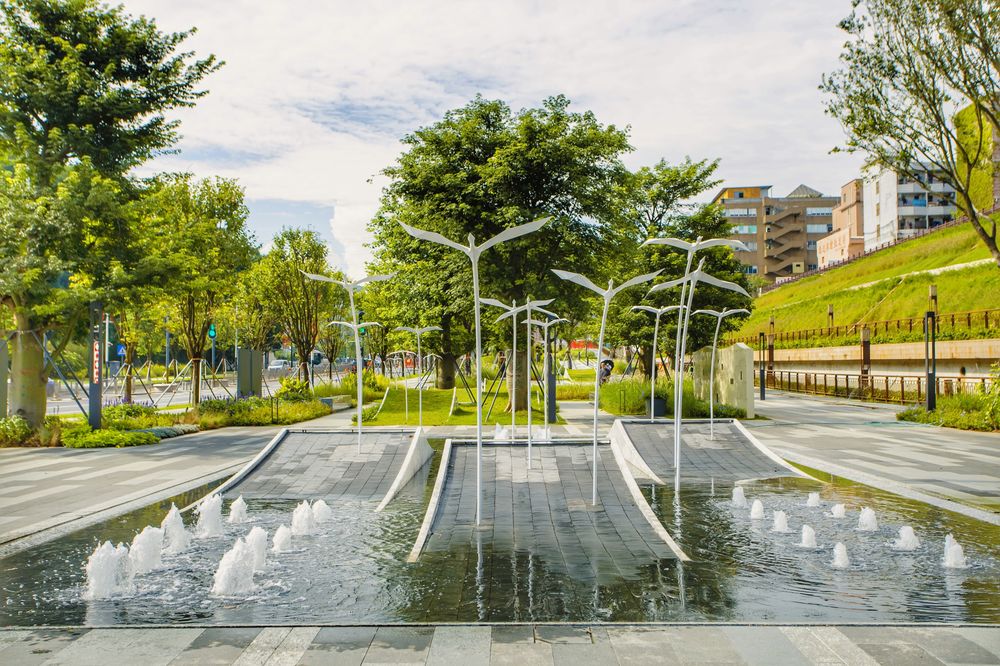
▼“白鹭”涉水夜景氛围“Egret”wading night scene atmosphere
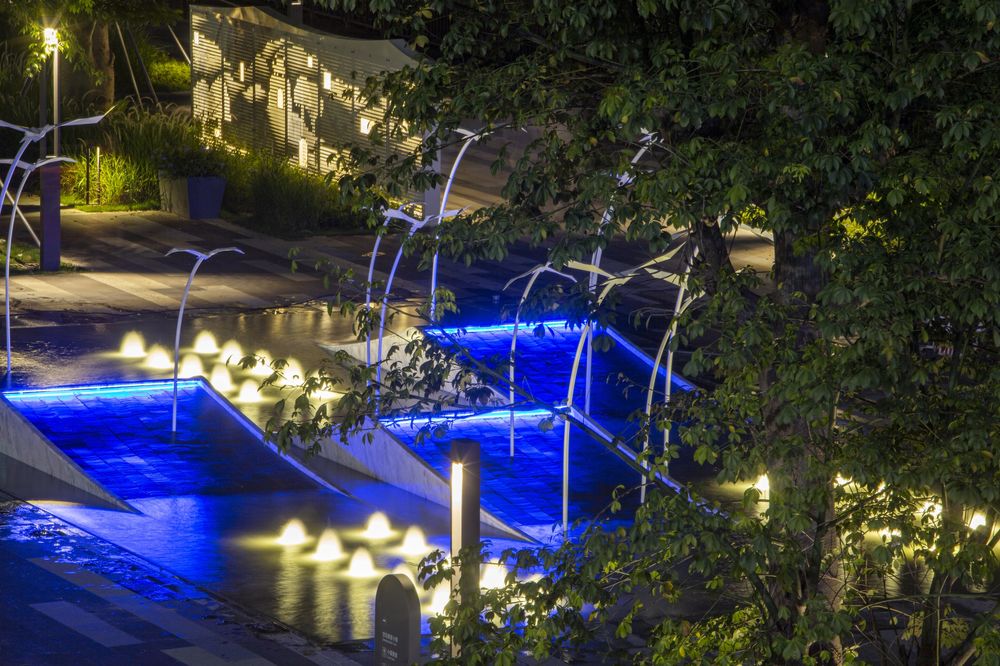
山墙拆解空间,置入互动的文化探索|Interactive cultural exploration
无动力画卷创意来自于儿时的跑马灯,基于摩尔纹和运动错觉的原理,通过人眼和孔洞的相对移动,童年的画片展现农户耕种、山水人家的隽永,步移景异,乐在其中。
The moorless wall is based on Moorish lines and the principle of motion illusion. Through the relative movement of human eyes and holes, it shows the meaningful picture of farmers’ farming, landscape and family in their childhood.
▼摩尔纹动态效果原理图 Schematic diagram of moore grain

▼摩尔墙实景-GIF Moore Wall Real Scene-GIF

▼画卷墙实景 Moore Wall
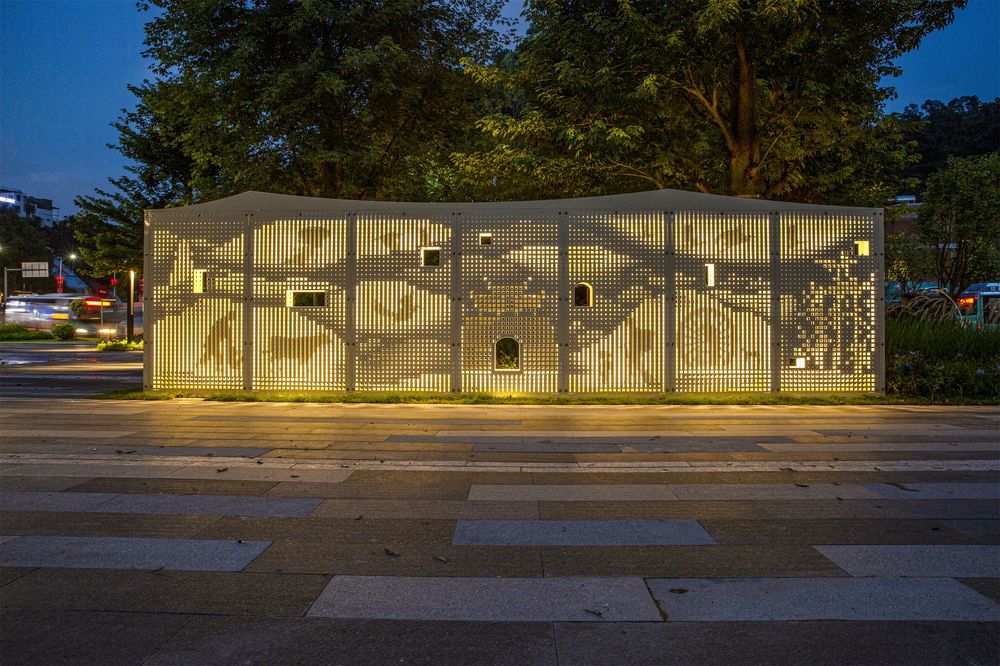
▼摩尔墙鸟瞰 Moore wall bird’s eye view

生态农耕、和谐共存,传承文脉、遇见未来,时光浮影在景墙中开启一条贯穿着传统聚落人文与历史脉络的探访路径,吸引你俯身一探究竟。
People in the time floating shadow landscape wall to open a traditional settlement in the cultural and historical context of the visit path.
▼条形砾石铺装空间 Strip gravel paving space
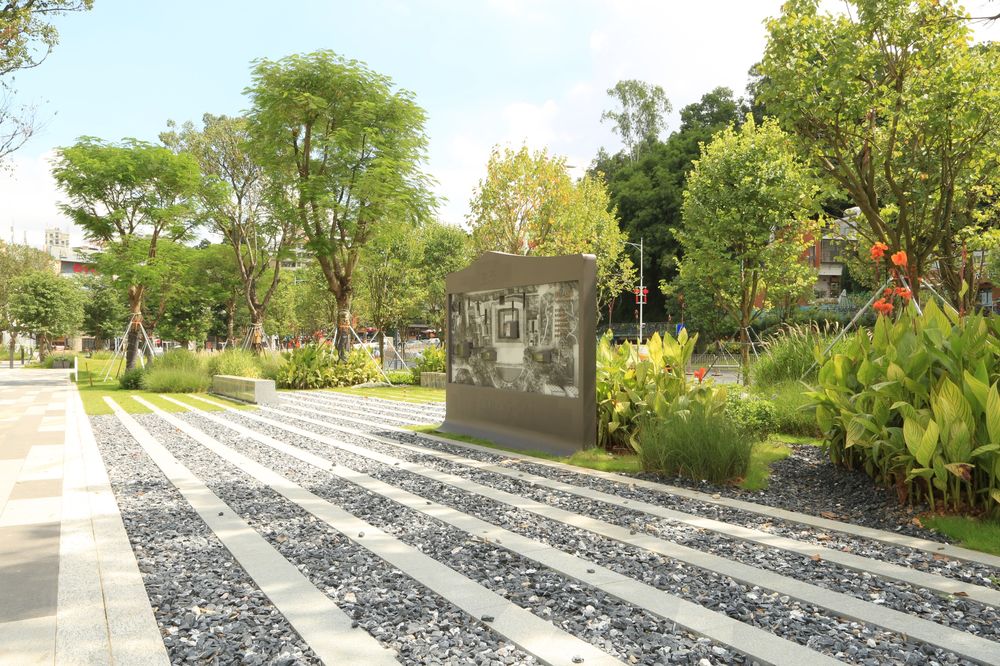
▼时光浮影景墙 Time Floating Shadow Wall
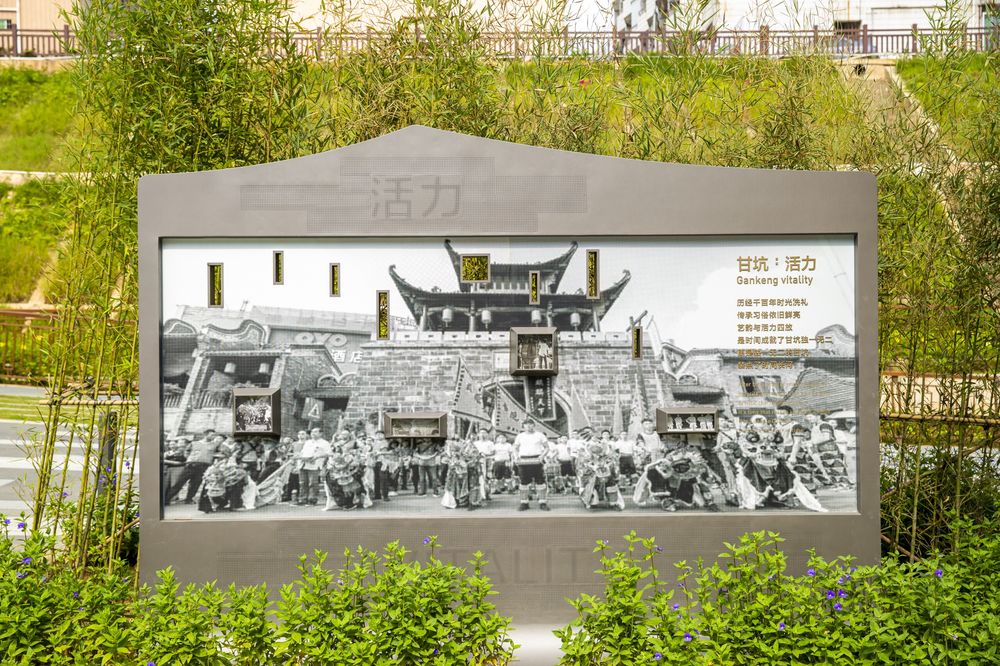
▼标识细节 Logo details
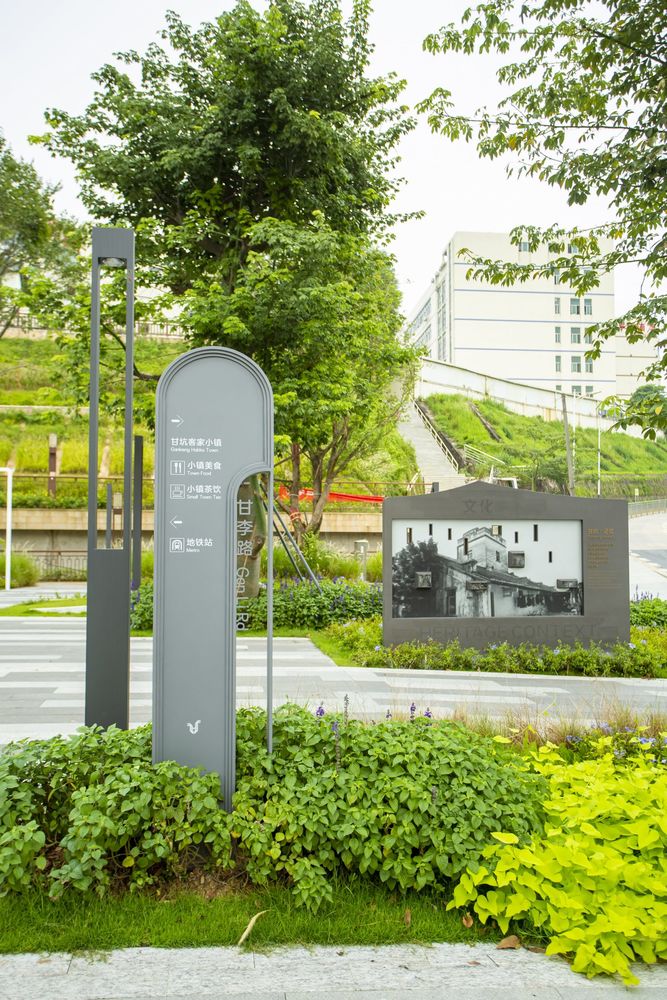
▼景墙细节 View wall details
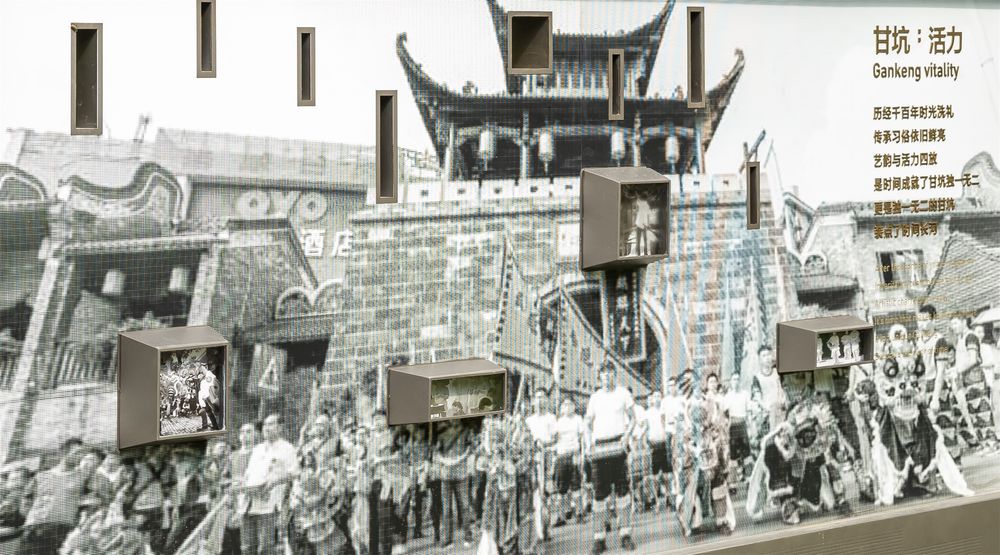
飞鸟造型的廊架提供了开放多元的休憩场地,也使得整个空间更加灵动。消极的边坡简单复绿作为飞鸟廊的背景,营造白鹭归来甘坑葱茏,四山环绕活水长流的画境。
The bird shaped corridor provides an open and diversified resting place and makes the whole space more dynamic. The negative slope is newly planted with green vegetation, which is used as the background of bird Gallery to create a verdant landscape with egrets returning to Gan Keng and four mountains surrounding the flowing water.
▼飞鸟廊 The corridor of bird modelling wears
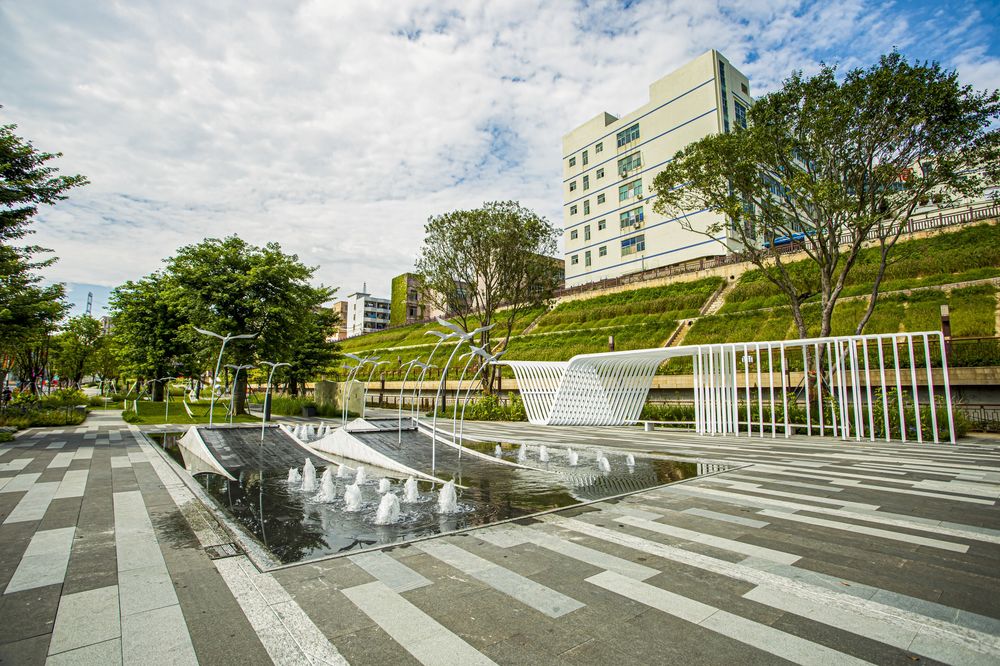
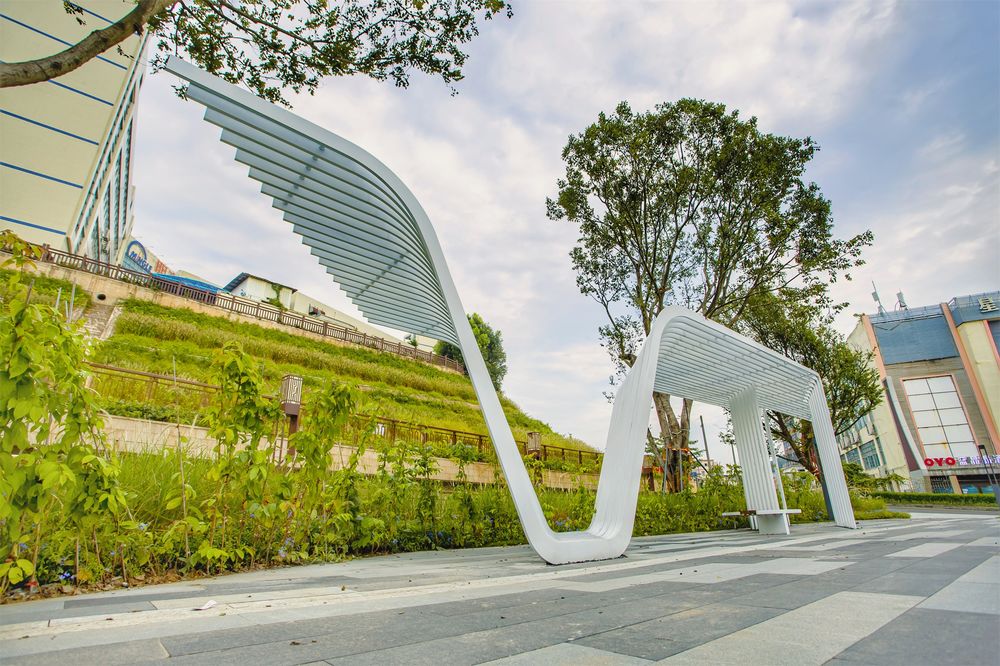

印记甘坑,凝聚文化认同感|Cultural identity
建成后的甘李路缔造了从甘坑地铁站至甘坑客家小镇的游览序列,传承了客家历史文脉。提供给人们使用便利的同时,也需要居民、游客、政府的共同维护,同时可以通过举办展览、节日庆典、学校研习活动,增强文化认同感。
Ganli Road created a tour sequence from Gankeng subway station to Gankeng Hakka town. It inherited Hakka historical context. In addition to providing convenience to people, residents, tourists and the government need to jointly maintain it. At the same time, exhibitions, festivals and school study activities can be held to enhance cultural identity.
▼可拆卸的树池篦子&小镇导览 Detachable tree pond grate & town tour

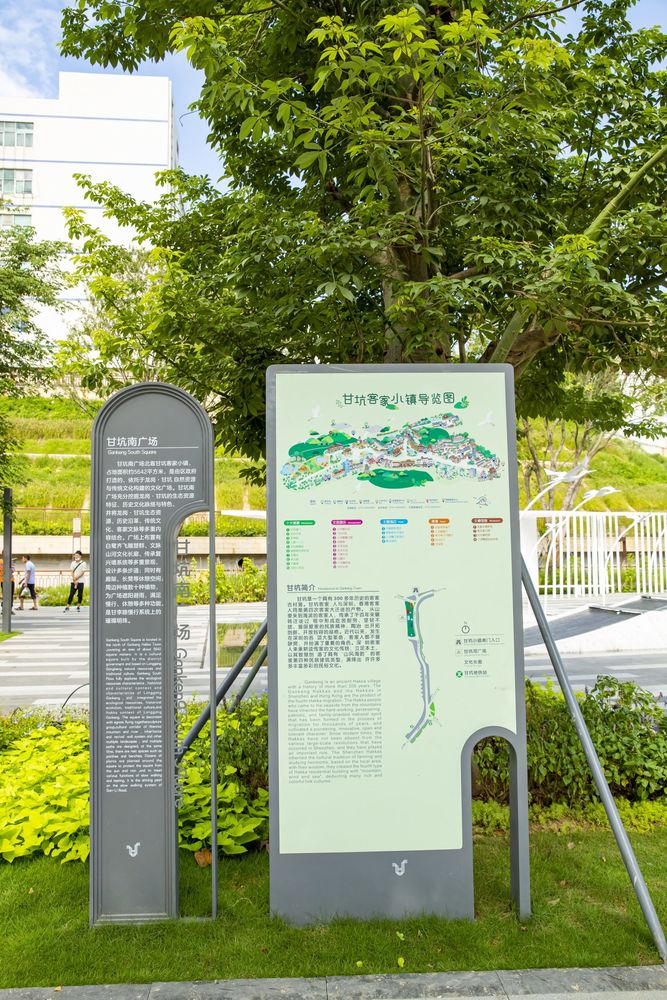
不锈钢止车柱&简约大气的公交站台 Stainless steel stop column & Simple and atmospheric bus station
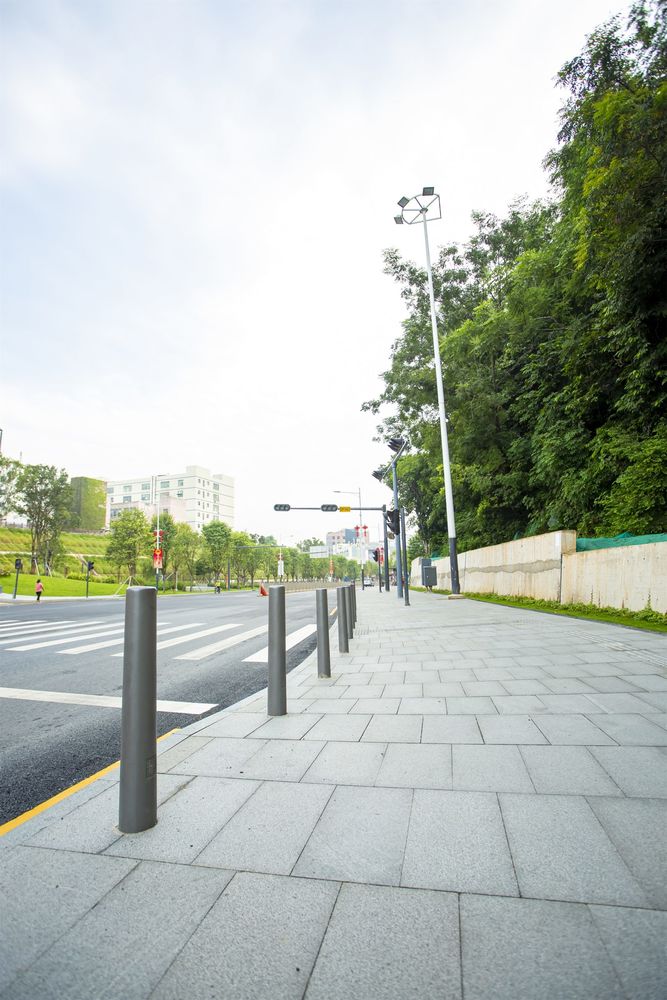
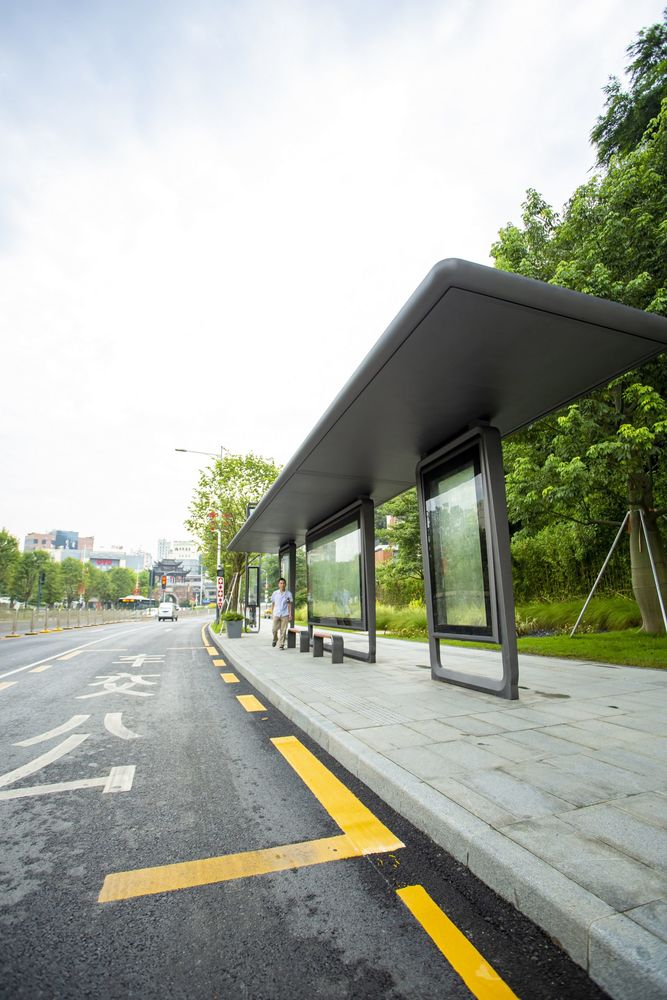
▼无障碍设计 Accessible Design
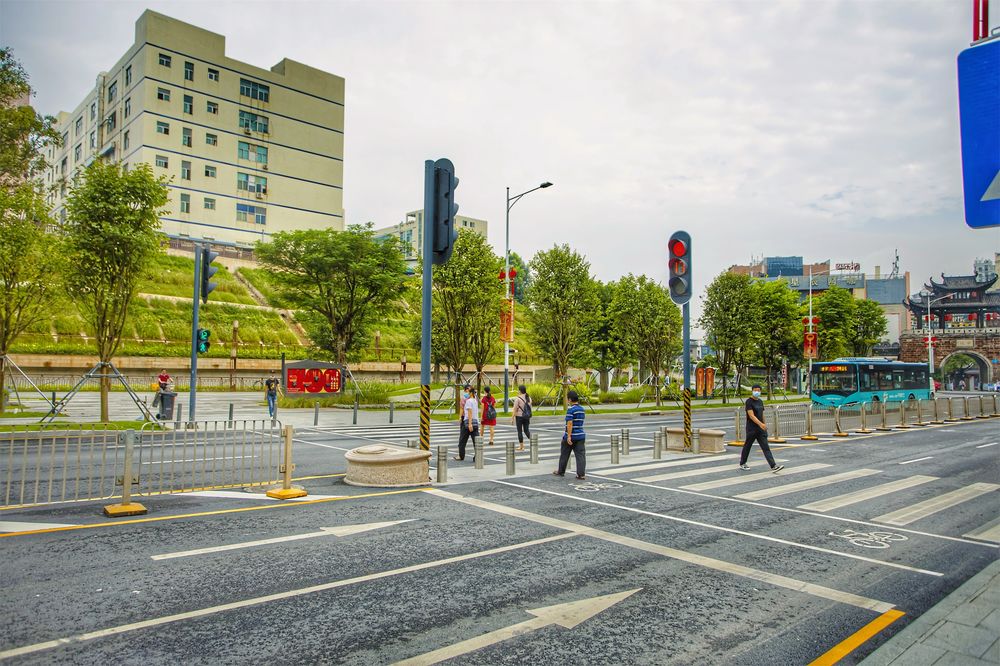
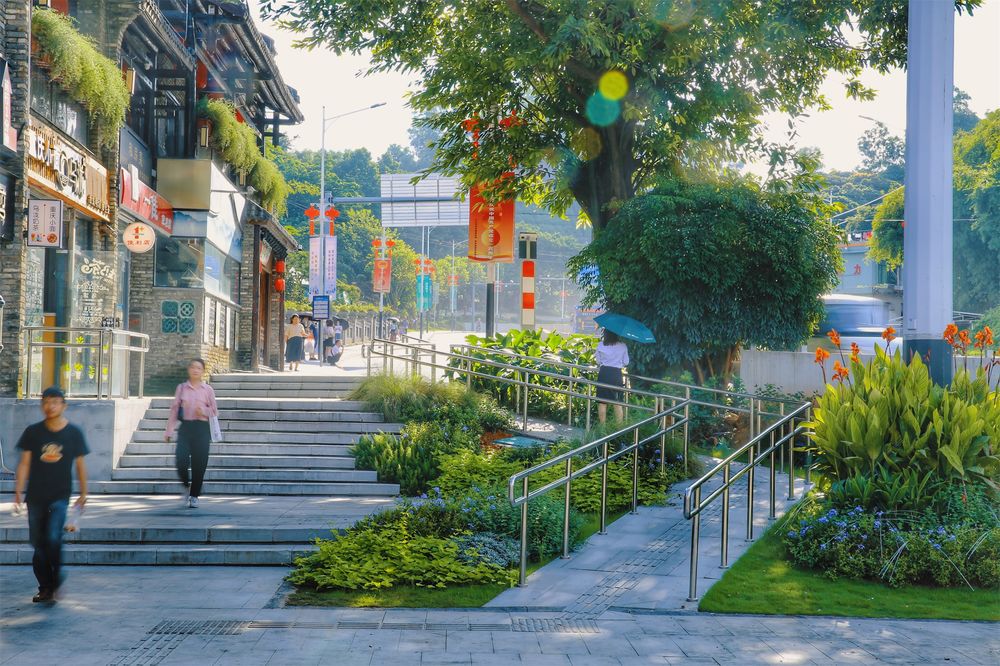
古街新貌,历史碰撞现代,过去连接未来。我们以白鹭纷飞展现山水自然,以客家元素刻画场地文脉,自此,客家文化在古镇围墙之外有了呼应的场地,东西南北人流在此交织汇聚,进而产生多彩丰富的场景现象、自然而然的人本空间。我们希望通过新街道与新古镇的对话,吸引越来越多的人前往,从而真正实现客家历史与文化的传承与发扬。
Ancient streets glow with a new look, history collides with the modern and the past connects the future. We use egrets to show the landscape and nature, and Hakka elements to depict the context of the site. From then on, Hakka culture has a corresponding site outside the walls of the ancient town, where the flow of people from the east, west, north and south interweave and converge, thus creating a colorful scene and natural human space. We hope to attract more and more people through the dialogue between the new streets and the new town, so as to truly realize the inheritance and development of Hakka history and culture.
▼总平面图 Plan
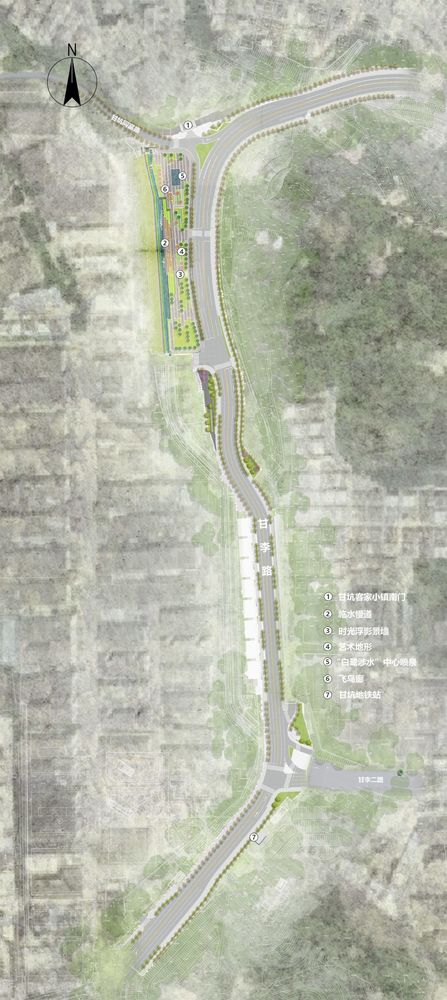
项目名称:甘坑客家小镇南门周边交通及慢行系统改造工程(甘坑地铁站至甘坑客家小镇南门)完成年份:2021.11
项目面积:道路长度1.13km
项目地点:深圳市龙岗区甘李路
设计公司:深圳市城市交通规划设计研究中心股份有限公司
主创设计师:程智鹏、高杨
项目总师:刘光辉,黄振宇,王志芳
设计团队:景观: 肖萌、陈杰、傅范宇、王国栋、朱川、张宸、魏冬冬、刘晓萍、陈志敏、马亚男、李丽华、吴霜、杜泽慧;
道路:张仲瑾、舒超、张旺;
水电:况旺、王超、唐星、范浩东;
结构:龚明;
工程经济:江逵、李政原
业主方:深圳市交通运输局龙岗管理局、龙岗吉华街道办事处
代建方:深圳华侨城文化置业投资有限公司
合作方: 深圳市天青文化传播有限公司、东南大学雕塑系
摄影师: 张杰(拍摄);高杨(后期)
Project Name: Transformation Project of Traffic and Slow Traffic System Around the South Gate of Gankeng Hakka Town (Gangkeng Subway Station to the South Gate of Gankeng Hakka Town)Year of completion: 2021.11
Project area: road length 1.13km
Project location: Ganli Road, Longgang District, Shenzhen
Design company: Shenzhen Urban Transportation Planning and Design Research Center Co., Ltd.
Lead designer: Cheng Zhipeng, Gao Yang
Project chief: Liu Guanghui, Huang Zhenyu, Wang Zhifang
Design team:Landscape: Xiao Meng, Chen Jie, Fu Fanyu, Wang Guodong, Zhu Chuan, Zhang Chen, Wei Dongdong, Liu Xiaoping, Chen Zhimin, Ma Yanan, Li Lihua, Wu Shuang, Du Zehui;
Road: Zhang Zhongjin, Shu Chao, Zhang Wang;
Hydropower: Kuangwang, Wang Chao, Tang Xing, Fan Haodong;
Structure: Gong Ming;
Engineering Economy: Jiang Kui, Li Zhengyuan
Owner: Longgang Administration of Shenzhen Municipal Transportation Bureau, Longgang Jihua Sub-district Office
Agent: Shenzhen Overseas Chinese Town Cultural Property Investment Co., Ltd.
Cooperative party: Shenzhen Tianqing Culture Communication Co., Ltd., Sculpture Department of Southeast University
Photographer: Zhang Jie (shooting); Gao Yang (Late)
"设计依托资源禀赋、留下城市文脉让其重新得到人们的关注。"
审稿编辑 王琪 – Maggie


